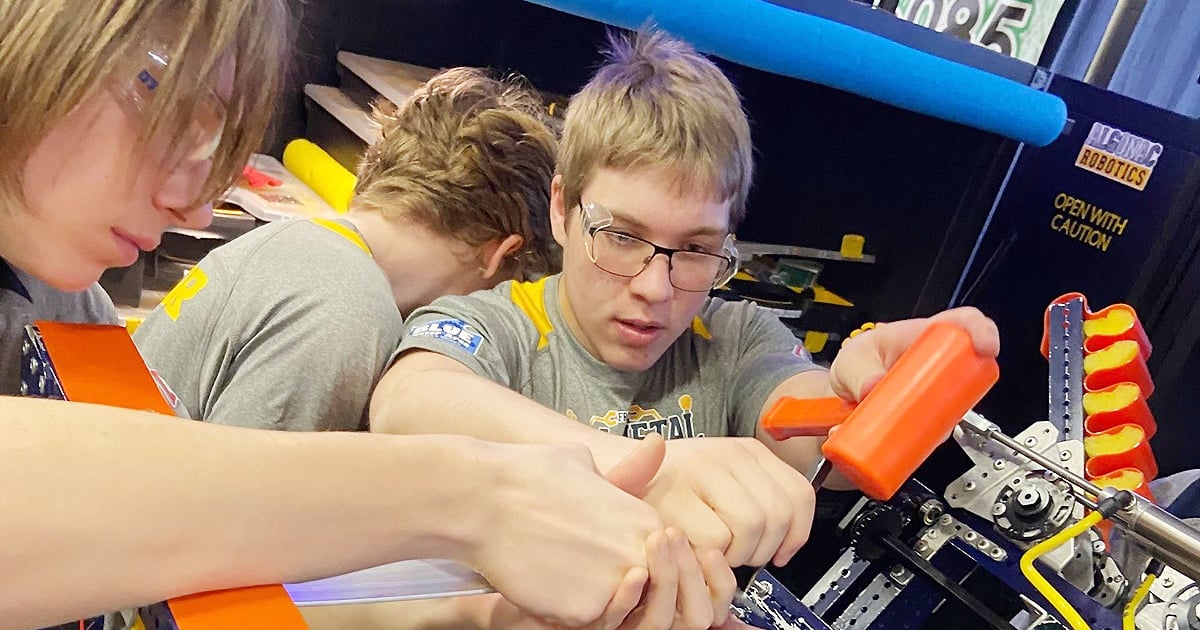
FLINT, Mich. — There’s a taped black line on the carpet at the entrance to the Algonac High School FIRST Robotics team’s pit area at the recreational center at Kettering University. That’s where about five students are working feverishly to fabricate a bracket that will keep their robot’s arm from retracting too far when it competes in the Michigan State Regional robotics competition against 39 other schools.
Just a few tense minutes remain before the next match, and the sense of urgency is real as a drill whirs and a hammer knocks a fastener into place. The Full Metal Muskrats — the name of the Algonac High School team — have to get it right. Mechanical issues cost points and can derail a school’s goal of making it to the state finals next month.
Sebastien Cournoyer, a plant manager at Cargill Corp. and one of the team’s mentors, stands behind that black line a few feet away and watches as students secure the bracket. “I know it’s not going to work,” he said in a low voice, as he fought the urge to intervene. Cournoyer believes they can learn from failure as well as success.
I was a judge this past weekend on the Ford Motor Co. team at a regional competition for FIRST Robotics. It was my third time judging.
The competitions taking place around the globe is a huge affair; in the United States, around 615,000 high school students work on robotic teams. The program, founded in the 1970s by inventor Dean Kamen, serves as an incubator for talent for just about every industry that needs engineers, software developers, fabricators, code writers and technicians.
FIRST teams in Michigan are heavily supported by the auto industry, with General Motors, Ford, Toyota, Stellantis and Bosch among the major donors of money, equipment, mentors and tools. But the industry’s strong support doesn’t mean it has dibs on these kids.
I conducted an informal survey of a couple dozen students, and only about a third said they wanted to work in the automotive industry or for a supplier. Aviation, medicine, data and agriculture careers were cited by students not interested in creating future automobiles. Several said they plan to forego college and instead seek jobs after high school that will train them as technicians. Some want to fix cars — good news for dealers struggling to recruit technicians.
What attracts some FIRST students to the auto industry are the very same technologies they are learning about with the robots they build — electrification and self-driving features.
As part of this year’s competition, the robots must operate autonomously for 15 seconds while performing several tasks. They are driven by small but powerful electric motors and can do such things as the tank turn and a version of the crabwalk, which are features of electric vehicles from Rivian and GMC Hummer.
“Some of the strategies they are designing in terms of controlling how the robot moves or how it operates its appendages to move the game pieces around and score points is a similar skill set to what we need to control vehicles,” said Birgit Sorgenfrei, a project lead on advanced driver assistance systems at Ford. The students planning on a career in the auto industry after working on a FIRST team often have an advantage over those who don’t participate, she said.
“When we’re looking at students for internships and when they’re interviewing for full-time positions at Ford, we look to see if they have FIRST experience,” said Sorgenfrei, a FIRST judge for more than 20 years.
As for the Algonac team, turns out the bracket wasn’t needed, Cournoyer said. The Full Metal Muskrats didn’t advance to the next round.
But winning isn’t the most important part, Cournoyer said. The most important lessons in FIRST Robotics competition, he said, are “teamwork and being able to work with others, being able to work under pressure, identifying when somebody else may be better at task than they are, and then learning from them.”